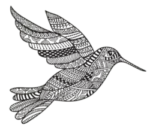Hummingbirds may be tiny, but their communication skills are nothing to sneeze at. From their dazzling displays of flight to the subtle (and sometimes not-so-subtle) sounds they make, these little creatures have quite the vocabulary when it comes to signaling their intentions. Whether it’s to establish dominance, attract a mate, or warn off an intruder, hummingbird communication is a fascinating mix of visual and auditory cues. So, let’s take a dive into the world of hummingbird chatter, shows of strength, and territorial behavior—because, believe it or not, these tiny dynamos have plenty to say!
The Sound of Hummingbirds: Whirrs, Chirps, and Trills
- Hummingbirds aren’t completely silent; they use sounds to communicate.
- The distinctive “whirring” noise comes from their rapidly beating wings.
- They also produce high-pitched chirps and whistles to communicate with others.
If you’ve ever been lucky enough to spot a hummingbird up close, you’ve probably heard the distinct sound of their wings whizzing through the air. This high-pitched “whirr” is the result of their wings beating up to 80 times per second! It’s a sound so characteristic of these birds that it’s often considered their “signature tune.” But while this wing beat may seem like a simple byproduct of flight, it also serves as a form of communication, signaling speed, agility, and sometimes even aggression.
In addition to their wing beats, hummingbirds also produce a range of chirps, whistles, and trills. These sounds are often higher-pitched than we can perceive, but other hummingbirds can hear them clearly. When two males are vying for the same territory, these vocalizations can get quite intense as they try to assert dominance. Meanwhile, females use these subtle sounds to communicate with their mates or alert other hummingbirds to their presence. It’s not quite a full-blown conversation, but it’s clear these birds are anything but quiet when it comes to getting their message across.
Flashy Displays: When Flight Becomes a Performance
- Hummingbirds perform impressive aerial displays to assert dominance.
- Males often show off their colors and abilities to attract mates.
- These displays can be highly acrobatic, showcasing their agility and stamina.
While hummingbirds may not be the most talkative birds, they certainly know how to put on a show. Male hummingbirds, in particular, use flashy flight patterns to assert their dominance over a territory and to impress potential mates. One common display involves high-speed dives, where the male climbs to great heights and then zooms down in a steep, almost vertical drop. At the last second, he pulls up sharply, creating a dramatic swoosh of air that can be heard by other birds in the area. This high-speed maneuver isn’t just for fun—it’s a way to demonstrate his strength, speed, and precision.
But it’s not all about daring dives; males also use their vibrant plumage to catch the eye of females. Their iridescent feathers, which change color depending on the angle of the light, are more than just eye candy—they’re a visual signal of the male’s health and genetic quality. The brighter and more vibrant the colors, the more likely the male is to attract a mate. These dazzling displays of color, combined with their impressive aerial stunts, make hummingbird courtship feel like a high-flying talent show!
Territorial Behavior: Defend Your Turf!
- Hummingbirds are highly territorial, especially when it comes to feeding grounds.
- Males aggressively defend specific areas against intruders.
- The threat displays can include chasing, calling, and even physical combat.
Hummingbirds aren’t exactly the kind of creatures to share their space—especially when it comes to feeding. These little birds are fiercely territorial, and they’ll go to great lengths to protect their favorite flowers, feeders, or any spot they consider a good source of nectar. If another hummingbird dares to enter their turf, they’ll waste no time in defending it with all the energy they can muster.
The defensive behavior can range from aggressive vocalizations (high-pitched chirps that signal “get out”) to full-on aerial chases. In these high-speed chases, the defending bird will swoop down and attempt to drive the intruder away with swift movements and threatening calls. Sometimes, things can escalate to physical combat, with the two birds locking talons in mid-air, flapping and darting in a dizzying display of speed and agility. It’s like a tiny aerial battle in the sky, with each bird showing off their skills and determination. In this way, territorial disputes are resolved in the most dramatic and high-energy manner possible.
The “I’m Here” Signal: Perch and Posture
- Perching behaviors also communicate dominance or availability for mating.
- A bird’s posture—whether perched upright or with tail feathers raised—can signal intent.
- Males often display themselves in prominent locations to attract females.
When a hummingbird isn’t zipping around at top speed, it’s often perched in a high place, keeping a lookout over its territory. The way a hummingbird positions itself can also be a form of communication. For instance, a male might perch in a high, visible spot, puffing out his chest and raising his tail feathers to make himself appear larger and more impressive. This display lets other males know that this territory is taken, while also signaling to any females that he’s available for courtship.
Females, too, use perch behavior to communicate. While they’re less flashy than the males, they’ll still perch in strategic spots to observe potential mates or scout out good feeding grounds. A female might tilt her head or puff out her chest to let other birds know she’s ready to engage in a courtship dance—or that she’s simply not interested and prefers to hang out peacefully.
Conflict Resolution: The Art of Hummingbird Diplomacy
- Hummingbirds usually resolve conflicts through displays rather than physical combat.
- Males engage in “staring contests” to determine who’s the dominant bird.
- Sometimes, the best defense is a graceful retreat.
As intense as the territorial disputes can get, hummingbirds generally prefer to resolve conflicts through non-violent means. In many cases, the male who shows the most strength and skill in his flight displays or vocalizations will be the one to win the territory, without ever engaging in a physical fight. Sometimes, these battles take the form of staring contests, where the two birds lock eyes from a distance and try to intimidate one another. It’s a true test of willpower and patience, as each bird tries to prove they’re the superior contender.
If one bird feels threatened but isn’t quite ready to fight, it might simply retreat—flying off to a nearby branch or flower, waiting for the other to lose interest. Sometimes, diplomacy in the hummingbird world involves knowing when to back down and when to come back stronger.
Conclusion: Tiny Birds, Big Messages
Hummingbirds may be small, but their communication is complex, diverse, and surprisingly effective. From their stunning aerial displays to their high-pitched chirps, these little birds know how to get their messages across, whether they’re defending their territory, attracting a mate, or simply saying “I’m here.” Their communication behaviors remind us that even the smallest creatures have fascinating ways of interacting with their world—and maybe even with each other. So, next time you see a hummingbird, take a moment to appreciate not just their beauty, but the remarkable ways in which they speak through sound, motion, and presence.


